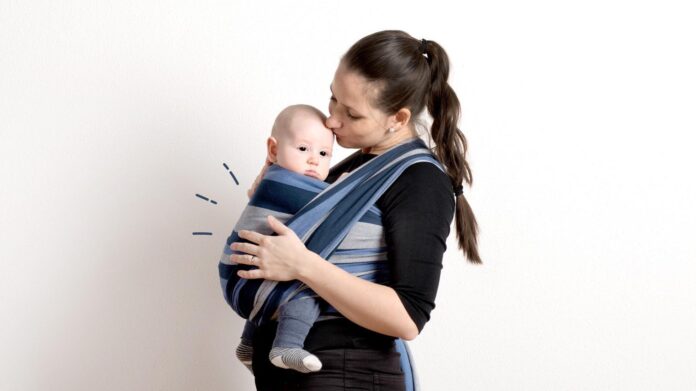For new mothers out there, keeping your newborns content and happy is your first priority. Yet most of the time, the only time they’re content is when you carry them in your arms. Gendongan Kain or traditional Indonesian soft fabric baby carrier or sling made from a single piece of 2 m batik fabric is one of the ways to be able to peacefully do your chores while also keeping your baby content.
Origins of Kain Gendongan
Tips for choosing the right gendongan cloth
For the sake of comfort and safety, mothers should choose a carrier according to the age of the baby. The reason is, if you choose the wrong one, your little one can get injured or their growth stunted.
Therefore, before buying a baby carrier, you need to pay attention to the following things:
1. According to the age and weight of the little one
Make sure the fabric that you choose is suitable for your baby’s body size, age, and weight. Do not let the fabric be too loose or too tight because it can interfere with the development of the baby’s body.
2. Safe and sturdy
Make sure the sling used is safe and sturdy, especially for the front and rear carrier types. In addition to safety, a sling like this can also be used for a long period of time.
So, when you buy a sling, make sure that the strength of the baby cradle and the support strap is really sturdy.
3. Comfortable to use
We recommend that you choose a carrier that is comfortable to use for all needs, especially breastfeeding. Don’t forget to also choose a sling made of material that is not too thick and easy to wash.
For mothers who have premature babies, you should consult a doctor first before buying a sling so that you don’t choose the wrong one and buy one that suits your needs.
Gendongan Type
1. Jarik Simpul Jangkar
The first variation of gendongan knots is Jarik simpul jangkar. In recent years, the method of carrying using jarik simpul jangkar has become quite popular. This technique is a basic technique and easy to apply.
By using the simpul jangkar technique, we can carry the child safely and comfortably and not easily feel sore and sore in the shoulder. In addition, the child’s position can also keep an eye on the M-shape position.
2. Simple Hip Carry
The next variation of carrying with jarik is the simple hip carry. Simple hip carry is a side-carrying technique by making the the shape of a pouch or geos. The trick is to position the jarik on the shoulder, then diagonally the two fabrics in the opposite direction to the shoulder.
Measure the length of the fabric approximately to the waistline then tie it off or use the flat reef knot technique. Twist the tie behind your back, then put the child in like using a pouch.
3. No No No Hip Carry
The next variation of carrying with jarik is no no no hip carry. This technique can be an alternative to carrying for mothers who have difficulty making simpul jangkar. Because in this technique, there are no knots and no ties. The position of the child can be at the waist or in front.
Although this technique seems easy to do, it is quite tricky because we have to make sure the size of the fabric is long enough so that we can tuck the rest of the fabric on our backs, not under the child’s bottom.
4. No Sew Ring Sling
The next variation of carrying with a jarik is the no sew ring sling. We can make ring slings without stitches. You do this by attaching two special rings to carry children, perfectly round in shape, without gaps and made of aluminum/nylon/polypropylene, at one end of the fabric.
No sew ring slings are easier than making simpul jangkar, but it can be a bit tricky to get a pair of these rings.
5. Double Jarik Simpul Jangkar
The variation of carrying with a jarik is the double jarik simpul jangkar. This technique requires two jariks, each of which is tied with a simpul jangkar. So there will be 2 simpul jangkar on our right and left. In the end, this double jarik simpul jangkar technique is like using instant stretchy wrap because there are 2 crossed pockets in front.
This technique can be an alternative if the mother is not strong enough to carry on one shoulder and there is no budget to buy another type of sling that is more comfortable.
6. Back Carry
The next variation of carrying with jarik is back carry. We can carry the child on the back using a sheet or two jariks depending on the technique we want. The simplest technique is the ruck tied under the bum, which is the ruck technique with the final tie under the child’s bottom. However, to carry a child on the back with a jarik, it requires a cloth that is long enough at least 2.6 meters.
There are many back carrying techniques that you can try, including the shepherd’s carry, half jordan back carry, and even using two pieces of jarik like carrying with a double jarik simpul jangkar in the front.
Other Things to Pay Attention to
In addition to understanding the type and how to choose the right gendongan, you should also pay attention to several things when using a gendongan, namely:
Practice using a sling
To be safe, mothers can practice using a sling first with a doll or plastic filled with rice. If you feel safe and confident, then you can carry your little one using the gendongan.
Learn to adjust the position of the gendongan
This is meant to find out a comfortable position for the baby. Make sure you can see your little one’s face clearly and that the baby can breathe freely. Don’t let your little one’s face be covered by the sling.
The gendongan can’t be too tight
If you use a gendongan, don’t wrap it too tightly, okay? If it’s too tight, your little one’s hips will be compressed and a hip joint disorder (hip dysplasia) can occur.
Don’t let your baby’s feet hang
When using a sling, make sure your little one’s feet don’t hang straight down. Make sure the position of the cloth or sling can support your little one’s feet sideways from the groin to the knee.
You can also arrange your little one’s feet so that they are wrapped around your body. If the baby’s legs are left hanging, they are at risk for hip dysplasia.
Be careful with your movements
One more thing to remember, avoid using a baby carrier when driving a car, jumping, jogging, or doing other activities that can shake or hurt your little one.
Have you tried using a gendongan? Share your experience in the comments section below!





